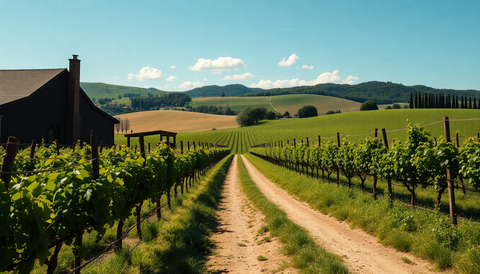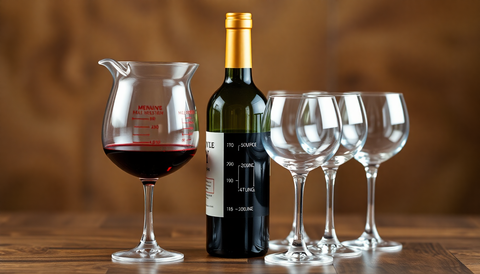How many calories in a glass of red wine? A quick answer
One 150 ml glass of red wine at about 13% alcohol by volume (ABV) typically contains roughly 120 to 130 calories. That number can shift meaningfully with pour size, alcohol percentage and residual sugar. In this 2025 guide we break down exact counts by serving size, wine style and pour, show the math so you can estimate any bottle, and offer practical tips for enjoying wine while managing calories.
Why red wine calories vary
- Alcohol content: Alcohol provides 7 calories per gram. Higher ABV wines contain more calories for the same volume.
- Residual sugar: Any sugar left after fermentation adds calories. Sweeter reds contribute noticeably more energy than dry reds.
- Serving size and pour: Many people pour larger than a 'standard' glass. Calories scale directly with volume.
- Other compounds: Small contributions come from glycerol and other nonfermented solids, but alcohol and sugar are the main drivers.
The formula: How to calculate calories in wine
Use this two part approach:
- Calories from alcohol = grams of alcohol × 7 kcal per gram
- Calories from sugar = grams of sugar × 4 kcal per gram
To get grams of alcohol in a serving use this conversion:
grams alcohol = ABV % × volume in ml × 0.789 / 100
0.789 is the density of ethanol in g/ml. Once you have grams of alcohol, multiply by 7 and add sugar calories if you know residual sugar.
Exact calorie counts by common serving sizes and typical ABV
Below are calculated examples using the formula. We use three representative ABV values for red wine: 12%, 13.5% and 15%. We assume the wines are dry with negligible residual sugar unless noted.
- 125 ml glass
- 12% ABV: about 95 kcal
- 13.5% ABV: about 107 kcal
- 15% ABV: about 119 kcal
- 150 ml glass (common standard pour)
- 12% ABV: about 114 kcal
- 13.5% ABV: about 128 kcal
- 15% ABV: about 143 kcal
- 175 ml glass (large pour)
- 12% ABV: about 133 kcal
- 13.5% ABV: about 150 kcal
- 15% ABV: about 168 kcal
- 250 ml glass (very large)
- 12% ABV: about 190 kcal
- 13.5% ABV: about 214 kcal
- 15% ABV: about 240 kcal
- Whole 750 ml bottle
- 12% ABV: about 570 kcal
- 13.5% ABV: about 642 kcal
- 15% ABV: about 720 kcal
Calories by red wine style: light, medium and full bodied
Different red styles have typical ABV ranges and sometimes different residual sugar. These values are approximate averages for a 150 ml glass and assume dry wines unless a sweetness level is specified.
- Light-bodied reds (eg Pinot Noir, Gamay)
- Typical ABV range 11.5 to 13% — about 105 to 120 kcal per 150 ml
- Medium-bodied reds (eg Merlot, Sangiovese)
- Typical ABV range 12.5 to 14% — about 120 to 135 kcal per 150 ml
- Full-bodied reds (eg Cabernet Sauvignon, Syrah, Zinfandel)
- Typical ABV range 13.5 to 15.5% — about 130 to 160+ kcal per 150 ml
- Sweeter reds or fortified styles (eg late harvest, some ports)
- Residual sugar can add 20 to 150+ kcal depending on sweetness. A demi-sec or sweet red can easily be 170 to 250 kcal per 150 ml. Fortified wines like port are much higher due to spirit addition.
Sample calculations so you can estimate any bottle
Example 1: 150 ml of wine at 13% ABV with negligible sugar
- grams alcohol = 13 × 150 × 0.789 / 100 = 15.4 g
- calories from alcohol = 15.4 × 7 = 107.8 kcal
- no sugar calories added in a dry wine, so total ≈ 108 kcal
Example 2: 150 ml of a slightly sweet red at 13% ABV with 8 g residual sugar per liter
- residual sugar in 150 ml = 8 g/L × 0.15 L = 1.2 g sugar
- sugar calories = 1.2 × 4 = 4.8 kcal
- alcohol calories = about 108 kcal as above
- total ≈ 113 kcal
How residual sugar changes the picture
Residual sugar is expressed in grams per liter (g/L). Typical dry table wines often have 0 to 4 g/L residual sugar. Off dry wines might be 6 to 20 g/L. Dessert and late harvest wines often exceed 40 g/L. To convert to calories in a single glass multiply the g/L by the glass volume in liters and then by 4 kcal per gram.
Calories in a bottle and by number of glasses
A standard 750 ml bottle contains five 150 ml glasses. Multiply per glass calories by five to estimate the bottle total. For example a 13% ABV dry red at 150 ml per glass is about 128 kcal per glass, or roughly 640 kcal per bottle.
Comparisons: red wine vs other alcoholic drinks
- Typical 150 ml glass of red wine (13%): about 120 to 130 kcal
- Light beer 355 ml: about 100 to 150 kcal depending on ABV
- Regular beer 355 ml: about 150 to 200 kcal
- Gin and tonic 1 standard shot with tonic: about 150 to 200 kcal depending on tonic sugar
- Cocktails: often substantially more due to mixers and syrups, frequently 250+ kcal
Red wine sits in the moderate range compared with many beers and cocktails, but a double pour or a sweeter wine can quickly exceed common alternatives.
Practical tips to reduce calories without giving up wine
- Choose lower ABV wines: pick bottles at 12% or lower when you want fewer calories.
- Opt for dry styles: lower residual sugar means fewer calories from carbohydrates.
- Mind the pour: use a measured pour or smaller glass size such as 125 ml.
- Alternate with water: decreases total intake and improves hydration.
- Share a bottle: splitting a bottle reduces individual calories consumed.
- Check tasting notes and ABV on the label to estimate calories before you pour.
Reading labels and estimating calories when nutritional info is not shown
Most wine labels list ABV but not calories. Use ABV and serving size in the formula above. If the producer mentions residual sugar or sweetness levels, factor that in. For example, an ABV 14% 150 ml pour with 10 g/L residual sugar contains roughly 140 kcal from alcohol plus 6 kcal from sugar for a total near 146 kcal.
Common questions and answers
- Is red wine lower in calories than white wine?
Not necessarily. Many white wines have similar ABV to reds. Sweeter whites can be higher in sugar, while some light red styles have lower ABV. Compare ABV and residual sugar rather than color alone.
- Does drinking red wine at dinner cause weight gain?
Calories contribute to energy balance. Regular excess calories will cause weight gain over time. Enjoying wine in moderation and accounting for its calories within your daily energy needs helps manage weight.
- Are there fewer calories in sparkling red or rosé?
Calories depend again on ABV and sugar. Many sparkling wines are lower in ABV but may have added sugar depending on style.
Quick calorie reference table for SEO friendly snippets
These short reference numbers are useful for quick answers and featured snippets:
- 125 ml glass of typical red (13%): about 105 kcal
- 150 ml glass of typical red (13%): about 120 to 130 kcal
- 175 ml glass of typical red (13%): about 140 to 155 kcal
- 250 ml glass of typical red (13%): about 200 to 215 kcal
- 750 ml bottle of typical red (13%): about 600 to 650 kcal
Takeaway: enjoy wine with informed choices
Calories in red wine are straightforward to estimate when you know ABV and serving size. Alcohol is the primary calorie source, with residual sugar adding more if the wine is sweet. A typical 150 ml glass of red wine in 2025 will usually be in the 110 to 150 kcal range depending on style and ABV. Use the formulas and tips in this guide to make choices that fit your taste and calorie goals, and remember that moderation and balance are the best approach to enjoying wine as part of a healthy lifestyle.
Further reading and tools
- Use a wine calorie calculator or the formula in this article to estimate calories from any bottle.
- Check ABV on the label and look for dryness statements to estimate residual sugar.
- If you track calories, log by pour size rather than glass shape to improve accuracy.
Updated 2025. If you want, I can create a printable quick reference card for different ABV levels and pours or a small calculator you can use on your phone.




Comments (0)
There are no comments for this article. Be the first one to leave a message!